第一章 翻译的基本知识
翻译的基本知识

一、翻译的定义什么时候有了一个民族或部落同另一个民族或部落的接触,什么时候就有了翻译。
西方自一世纪、中国自商周时期开始就有了跨语言翻译(inter-lingual translation)。
唐代贾公彦在《义疏》中写道:“译即易,谓换易言语使相解也。
”《辞源》对翻译的解释是:“用一种语言表达他种语文的意思。
”《大英百科全书》:“将用一种语言或者一套语言符号所表示的内容用另一种语言或者一套语言符号进行转换的行为或者过程。
”对于翻译较为完整的定义,要数现代翻译家奈达的:Translation consists in producing in the receptor language the closestnatural equivalent of the source language message, first in terms of meaning and secondly in terms of style.即所谓翻译,是指从语义到文体上在译语中用最切近而且最自然的对等语再现原语的信息,首先在语义上,其次在文体上。
人物简介贾公彦-贾公彦(生卒年不详,活动期公元7世纪中叶)中国唐代学者。
铭州永年(今河北永年县)人,唐高宗永徽元年(650年)发现指纹的特征及用途。
他官至太学博士。
撰《周礼义疏》50卷、《仪礼义疏》40卷。
指纹是手指远端掌面的凹凸花纹。
由长短、形状、粗细、结构不同的纹线组成,分弓、箕、斗三种基本类型,具有终生不变、各不相同的特点。
因此,指纹被广泛用作侦破案件、人身保险、研究遗传疾病和人的自然素质的依据,成为法医学和遗传学等学科的重要研究课题。
据德国R·海因德尔撰写的《指纹鉴定》(1927年)一书中指出:“世界上第一个用作鉴定的指纹的著作者是中国唐朝的贾公彦,他是唐代的著作家。
他的作品大约写于公元650年,他是着重指出指纹是确认个人的方法的第一人”。
贾公彦,其字不详,唐州永年(今河北邯郸市东北)人。
翻译基本知识
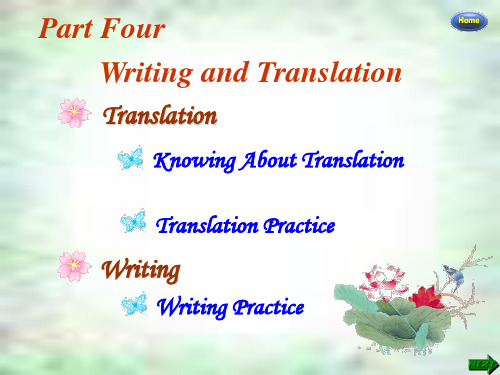
Translation
Translation Technique —Proper Omission of Words
省 略 译 法
由于中文和英文存在许多差异, 翻译时除了增添词语之外,还要适当 省略词语。汉语是意合语言,尤其讲 究简洁顺畅,英译汉时,要舍去原文 需要而译文不需要的成分。汉语也有 其自身的表达特点,汉译英时,也要 省略原文需要而译文不需要的成分。
省略其他词
英 译 汉 省 略 其 他 词
为了译文的流畅,根据上下文意思,其他 一些可有可无的词也可省略,完全直译反 而显得啰嗦。
To be continued
Part Four: Writing and Translation>>Translation
1) The fact that she was sacrificing her resting time before going to work so that I could learn English made me see the strength she possessed.
每个人生来都是独特的。(The word “something” is omitted. )
Part Four: Writing and Translation>>Translation
Section B Translate the following sentences into English. Pay attention to the omission of words.
Part Four: Writing and Translation>>Translation
Translation Practice
翻译的基本要求

翻译的基本要求————————————————————————————————作者:————————————————————————————————日期:翻译的基本要求第一讲:翻译的基本要求、原理、理解与表达、可读性1. 翻译的基本要求(一)透彻理解英文意思下面的例句在不同的语境中可有不同的含义:例1. It’s getting hot in here.如直译:这里热起来了。
如作为语用含义,可译为:请求某人打开门窗。
如作为反语:抱怨这地方太热。
如作为比喻:指争论在升级,吵闹激烈起来了。
语用含义不是揭示人们说了些什么,而是告诉人们说这句话可能意味着什么。
语用学中语境在这起着至关重要的作用,在翻译过程中,语言的语用含义往往比词语本身所具备的意义更为重要。
这种翻译就是我们所说的语用等效翻译。
如果翻译的目的是为了使读者准确理解原文的内涵,那么译者就要根据原著所提供的语境依从读者的文化习俗,在忠实原著的前提下将原作化为读者乐于接受的译文形式即可。
在实际操作中,“意译法”是常用的手法。
所谓意译(free translation),是指通过对原文深层意蕴的理解和消化,将原文的表层解构打破和重组,尔后转化为译文自然流畅的表层解构,“意译法”的核心是灵活变通。
为了追求全面的、整体的和真正的意义等效和功能相当,通过打破原文架构的方法,以便寻找最佳表达。
吕叔湘先生曾经举过一个例子。
原文如下:例2. She knew I knew and she knew if she got funny I’d either ruin the romance or make her marry him, so she was very friendly.误译:她很了解我,我很了解她;要是她遭遇困难,我的牺牲我们的浪漫,让她同他结婚,因为她待我太好了。
[译文]她知道我知道她和他的事,她也明白她要是跟我过不去,破坏或成全他们全在我的一念之间,所以她对我很客气。
翻译基础知识

翻译基础知识一、翻译的分类1.按所涉及的两种代码的性质,可分为语内翻译(intralingual translation)、语际翻译(interlingualtranslation)、语符翻译(inersemiotic translation)。
2.按翻译主体的性质,可分为人工翻译、机器翻译(Machine Translation)两类。
3.按翻译的工具和成品形式,可分为口译和笔译。
4.按翻译的客体,亦即所译资料的性质,可分为文学翻译(literal translation)和实用翻译(pragmatictranslation)。
二、译家译论1.支谦:在三国时期,支谦的《法句经序》中提出了“因循本旨,不加文饰”的译经原则。
2.道安:晋、前秦时道安在《革卑婆沙序》中提出,“案本而传,不令有损言游字;时改倒句,余尽实录。
”道安涉及译论的佛经序文较多,最有名的是提出“五失本”、“三不易”之说。
其意思是,翻译佛经在五种情况下会失去本来面目,有三件事决定了译事是很不容易的,因此必须慎之又慎。
3.彦琮:北朝末年及隋初,彦琮著《辨证论》,它可以看作是我国第一篇翻译专论,他主张译经“宁贵朴而近理,不用巧而背源”。
可见他是坚持忠实第一并倾向于直译的。
4.玄奘:唐代僧人玄奘的指导原则是:“既须求真,又须喻俗”。
“求真”即追求准确,要力求“忠实原作”,这是一切认真负责的翻译工作者的共同理想。
同时必须“喻俗”,亦即使群众理解,这就是说要“通顺”。
玄奘在译经中成功地运用了补充法、省略法、变位法、分合法、译名假借法、代词还原法等等翻译技巧。
5.马建忠:清末,马建忠在其《马氏文通》中提出“善译”之说:“必先将所译者与所以译者两国之文字,深嗜笃好,字栉句比,以考彼此文字孳生之源,同异之故。
所有当相之实义,委曲推究,务审其声音之高下,析其字句之繁简,尽其文体之变态,及其义理精深奥折之所由然。
”6.林纾:林纾强调在翻译时译者应该投入自己的主观感情,译者须与原作者或作品中人物的心灵相交流。
专业英语翻译基本知识
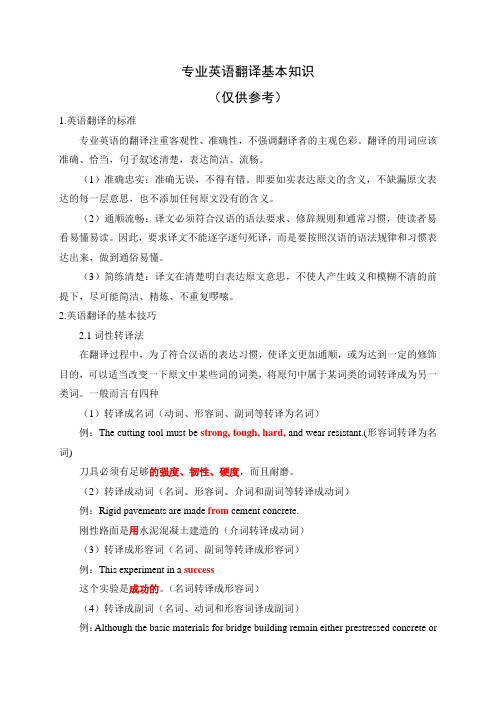
专业英语翻译基本知识(仅供参考)1.英语翻译的标准专业英语的翻译注重客观性、准确性,不强调翻译者的主观色彩。
翻译的用词应该准确、恰当,句子叙述清楚,表达简洁、流畅。
(1)准确忠实:准确无误,不得有错。
即要如实表达原文的含义,不缺漏原文表达的每一层意思,也不添加任何原文没有的含义。
(2)通顺流畅:译文必须符合汉语的语法要求、修辞规则和通常习惯,使读者易看易懂易读。
因此,要求译文不能逐字逐句死译,而是要按照汉语的语法规律和习惯表达出来,做到通俗易懂。
(3)简练清楚:译文在清楚明白表达原文意思,不使人产生歧义和模糊不清的前提下,尽可能简洁、精炼、不重复啰嗦。
2.英语翻译的基本技巧2.1词性转译法在翻译过程中,为了符合汉语的表达习惯,使译文更加通顺,或为达到一定的修饰目的,可以适当改变一下原文中某些词的词类,将原句中属于某词类的词转译成为另一类词。
一般而言有四种(1)转译成名词(动词、形容词、副词等转译为名词)例:The cutting tool must be strong, tough, hard, and wear resistant.(形容词转译为名词)刀具必须有足够的强度、韧性、硬度,而且耐磨。
(2)转译成动词(名词、形容词、介词和副词等转译成动词)例:Rigid pavements are made from cement concrete.刚性路面是用水泥混凝土建造的(介词转译成动词)(3)转译成形容词(名词、副词等转译成形容词)例:This experiment in a success这个实验是成功的。
(名词转译成形容词)(4)转译成副词(名词、动词和形容词译成副词)例:Although the basic materials for bridge building remain either prestressed concrete orsteel, there have been some recent changes尽管建桥的基本材料仍然是预应力混凝土或钢材,但近来已经有些变化了。
英汉翻译基础知识
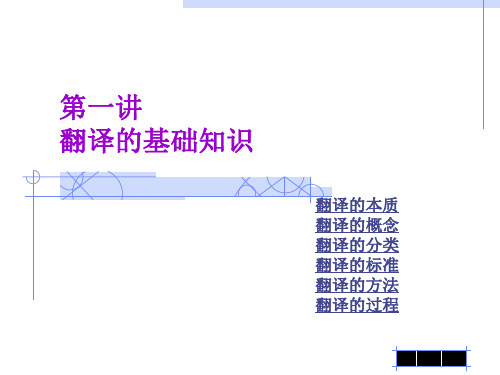
3. The Pananmanian leader publicly insinuated that he possessed compromising information about Mr.Bush that was liable to harm his bid for the White House.
8. 生产多了,价格就稳定,甚至下降一点。 (这两组例句可供学生尝试翻译并与原文进行对比, 从而加深对英汉两种语言各自特征的认识。)
页面 15
2019/7/29
总结说明
对这两组例句进行对比,可以得出如下结论:
1 .英语句子大多开门见山,搭起主谓空间结构(SV) ,形成句子主干(如句中划线部分所示),可参照下 页英语句子的树式结构;汉语则不一定是主谓结构, 如例(6)就属于“话题---说明”框架
页面 8
2019/7/29
汉英语言文化对比
页面 9
2019/7/29
1. 谱系(family):汉语属于汉藏语系,英语属于印欧语 系
2. 类型(type):汉语是分析型(analytic)语言,其典型 特征是没有屈折变化(inflection),即汉语的词没有词 性和词形的变化;英语是分析型和综合型(synthetic) 语言,有丰富的屈折变化形式。
页面 14
2019/7/29
再看一组汉语句子:
5.老关忙即跳下车去,摸摸腰间的勃郎宁,又向四下里 瞥了一眼,就过去开了车门,站在门旁边。
基础翻译课后答案

I 课内练习答案第一章翻译理论第一节翻译的基本原理课前活动第一句来自自马克吐温《密西西比河上的生活》。
原文是优美的景物描写。
(见“补充文字材料”。
)译文1没有翻译出原文风格;译文2是百度翻译的,完全不通顺。
译文3较好地做到了信达雅。
第二句来自一篇科普文章。
第一个翻译文白间杂,滥用四字成语,不符合原文的语体风格。
第二个较好地做到了“信达切”,但对kingdom的词义选择有误。
第一二句分别属于不同的genre(体裁),这就意味两个文本的语体风格不同:第一个语篇为散文语体,第二个语篇为说明文,因此属于不同的register(语域,指因使用场合、对象、领域等不同有不同的语体;语言的具体变体),而语域的不同决定了语言词汇范围选择不同。
散文体使用优美的文字和四字描写成语比较多,而说明文体的语言要求文字严谨、准确、易懂。
通过分析两个源语文本的文体风格,两个语篇的翻译选项谁优谁劣就不难做出选择了。
第三句来自Thomas Henry Huxley 的Evolution and Ethics, 译文1来自2010年的版本《进化论与伦理学》(宋启林等译),译文2来自1896年严复的版本《天演论》。
由于历史的原因,两个版本不存在孰优孰劣。
老师可以借讨论最后一个例子引入严复“信达雅”的翻译标准,并鼓励学生各抒己见。
思考与练习1.翻译的定义五花八门,对它们的归类可以因角度而异。
根据你的阅读积累和思考,对翻译定义还可以如何进行分类?答:翻译定义可以因为翻译的视角、翻译的目的、翻译所涉的领域不同而不同;也可以因为翻译时代的不同而不同以及翻译的诉求不同而不同。
例如,有基于语言层面的定义、超越语言层面的、有交际理论层面的还有艺术层面的等等。
2.请你介绍一两个令你印象最为深刻的翻译定义。
答:美国当代语言学家以翻译理论家和实践家尤金.A.奈达的著名翻译论断:Translation means translating meaning. 这个定义既简练又不简单。
口译基础理论和技巧
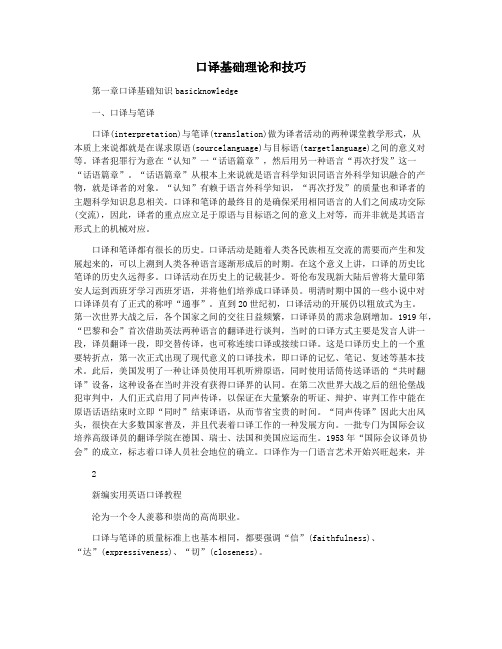
口译基础理论和技巧第一章口译基础知识basicknowledge一、口译与笔译口译(interpretation)与笔译(translation)做为译者活动的两种课堂教学形式,从本质上来说都就是在谋求原语(sourcelanguage)与目标语(targetlanguage)之间的意义对等。
译者犯罪行为意在“认知”一“话语篇章”,然后用另一种语言“再次抒发”这一“话语篇章”。
“话语篇章”从根本上来说就是语言科学知识同语言外科学知识融合的产物,就是译者的对象。
“认知”有赖于语言外科学知识,“再次抒发”的质量也和译者的主题科学知识息息相关。
口译和笔译的最终目的是确保采用相同语言的人们之间成功交际(交流),因此,译者的重点应立足于原语与目标语之间的意义上对等,而并非就是其语言形式上的机械对应。
口译和笔译都有很长的历史。
口译活动是随着人类各民族相互交流的需要而产生和发展起来的,可以上溯到人类各种语言逐渐形成后的时期。
在这个意义上讲,口译的历史比笔译的历史久远得多。
口译活动在历史上的记载甚少。
哥伦布发现新大陆后曾将大量印第安人运到西班牙学习西班牙语,并将他们培养成口译译员。
明清时期中国的一些小说中对口译译员有了正式的称呼“通事”。
直到20世纪初,口译活动的开展仍以粗放式为主。
第一次世界大战之后,各个国家之间的交往日益频繁,口译译员的需求急剧增加。
1919年,“巴黎和会”首次借助英法两种语言的翻译进行谈判,当时的口译方式主要是发言人讲一段,译员翻译一段,即交替传译,也可称连续口译或接续口译。
这是口译历史上的一个重要转折点,第一次正式出现了现代意义的口译技术,即口译的记忆、笔记、复述等基本技术。
此后,美国发明了一种让译员使用耳机听辨原语,同时使用话筒传送译语的“共时翻译”设备,这种设备在当时并没有获得口译界的认同。
在第二次世界大战之后的纽伦堡战犯审判中,人们正式启用了同声传译,以保证在大量繁杂的听证、辩护、审判工作中能在原语话语结束时立即“同时”结束译语,从而节省宝贵的时间。
第一讲 翻译的基本概念和问题

通顺: 译文语言通顺易懂,自然流畅,符合译文语言表达习惯, 没有文理不通、晦涩难懂等现象。
例1:Darkness released him from his last restraints. 原译:黑暗把他从最后的顾忌中解放出来。 改译:在黑暗中,他就再也没有什么顾忌了。 例2:语言这个东西,不是随便可以学好的,非下苦功不 可。 原译:Language is something difficult to learn well and to learn it well one has to study very hard. 改译:The mastery of language is not easy and requires painstaking effort.
例2:What is done by night appears by day. 原译:夜晚做的事白天就看见了。 改译:要想人不知,除非己莫为。
例3:从小儿三灾八难,花的银子也照样打出你这么 个银人儿来了。(《红楼梦》) 原译:You‟ve had three mishaps and eight disasters since you were a boy, the money we‟ve spent on you would make a person made of silver. 改译:You‟ve had one trouble after another since you were a boy, the money we‟ve spent on you would make a silver statue bigger than you.
E. A. Nida(尤金· 奈达)提出的翻译标准(1964) 1. true to the original 2. vivid 3. smooth and natural 4. equivalent of response (忠实于原文、传神、语言顺畅自然、同等效应) “Readers of TL must have the same response to the text with that of readers of SL despite of different means of expressions.” (尽管语言表达形式不同,译文读者读译文取得的 心理反应要和原文读者读原文的心理反应基本相 同。) Dynamic Equivalence 动态对等 →Functional Equivalence 功能对等(p.8-9)
专业英语阅读与翻译基础知识
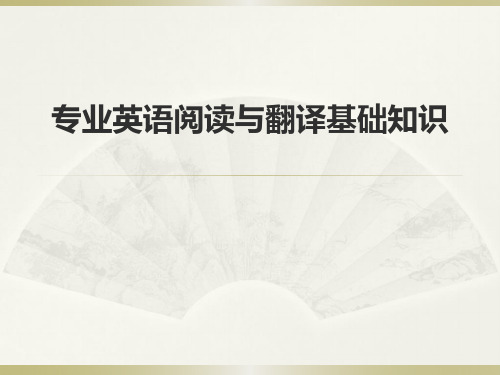
※ 惯用法 since从句中的过去 式联系动词was或 were是使一种状态 的结束。
又如 John is with his parents in New York City; it is already three years since he was a bandmaster. 译为:约翰现同父母住在纽约市;他不担任 乐队指挥已三年了。
专业英语阅读与翻译基础知识
一、翻译的标准和过程
1.翻译的标准 (1)忠实 译文要忠实于原文,准确地、完整地表达 原文的内容。译者不得任意对原文内容加 以歪曲、增删、遗漏和篡改。 (2)通顺 译文语言必须通顺易懂。 (3)符合规范 用词造句应符合本民族语言的习惯,用民 族的、科学的、大众的语言。
(4)注意从句套从句的复杂语言现象
A. We must therefore conclude that when the distance between the molecules is very small, there are forces of repulsion and that these forces increase rapidly as the distance between the molecules decreases.
B. Saturated steam is that which is in the
presence of, and at the same temperature as the water from which it was evaporated.
Saturated steam is that which is in the presence of, and at the same☆ temperature as☆ the water(is)from which it was evaporated. in the presence of的宾语是as从句内的主语 water。看到as时,必须注意前后有否相搭 配的词。这里乃是the same和as相呼应。 译为:饱和蒸汽是那种同蒸发它的水同时 存在,并具有与蒸发它的水同样温度的蒸 汽。
《英语翻译教案》课件

《英语翻译教案》PPT课件第一章:翻译的基本概念1.1 翻译的定义解释翻译的概念强调翻译的目的是传递信息和文化1.2 翻译的类型介绍不同类型的翻译,如直译、意译、同声传译等解释每种翻译类型的特点和应用场景1.3 翻译的标准和原则介绍翻译的标准,如准确性、可读性、忠实原文等强调翻译时应遵循的原则,如保持原文的意义和风格第二章:翻译的基本技巧2.1 词汇翻译技巧解释词汇翻译的基本原则,如词义选择、词性转换等举例说明常用翻译技巧,如直译、意译、借译等2.2 句子翻译技巧介绍句子翻译的基本原则,如句子结构对等、语序调整等举例说明常用翻译技巧,如被动语态的转换、从句的翻译等2.3 段落和文章翻译技巧解释段落和文章翻译的基本原则,如连贯性、一致性等举例说明常用翻译技巧,如段落结构的调整、文章风格的保持等第三章:英语语法和句型3.1 英语语法基本概念介绍英语语法的基本概念,如时态、语态、语气等强调语法在翻译中的重要性3.2 英语句型结构解释英语句型的基本结构,如主谓宾结构、主谓表结构等举例说明不同句型的翻译方法3.3 英语特殊句型和短语介绍英语特殊句型和短语的翻译方法,如倒装句、省略句等举例说明常用特殊句型和短语的翻译技巧第四章:文化差异与翻译4.1 文化差异对翻译的影响解释文化差异对翻译的影响,如语言表达习惯、文化背景知识等强调翻译时应注意文化差异的重要性4.2 英语和汉语的文化差异举例说明英语和汉语在词汇、表达方式、语法等方面的文化差异强调翻译时应考虑目标语言的文化背景4.3 翻译中的文化适应和调整介绍翻译中如何进行文化适应和调整,如词义选择、增减内容等举例说明文化适应和调整的翻译技巧第五章:翻译实践与评价5.1 翻译实践的重要性强调翻译实践在学习和提高翻译能力中的重要性鼓励学生积极参与翻译实践,提高翻译技能5.2 翻译评价的标准和方法介绍翻译评价的标准,如准确性、流畅性、忠实原文等解释翻译评价的方法,如同行评审、自我评价等5.3 翻译实践案例分析提供翻译实践案例,让学生进行翻译和评价分析案例中的翻译优点和不足,提供改进建议第六章:翻译软件与工具6.1 翻译软件的概述介绍目前市面上常见的翻译软件和工具,如谷歌翻译、DeepL等强调翻译软件在辅助翻译工作中的作用6.2 翻译软件的使用方法详细讲解如何使用翻译软件进行翻译强调翻译软件的局限性,如准确性、语境理解等6.3 翻译软件与人工翻译的结合介绍如何将翻译软件与人工翻译相结合,以提高翻译效率强调翻译软件只能作为辅助工具,不能完全替代人工翻译第七章:口译技巧与实践7.1 口译的基本概念解释口译的概念和类型,如同声传译、交替传译等强调口译的特点,如即时性、准确性等7.2 口译技巧介绍口译技巧,如听力训练、短期记忆训练、语言表达训练等强调口译技巧在实际口译工作中的重要性7.3 口译实践与评价提供一个口译实践案例,让学生进行口译练习分析案例中的口译优点和不足,提供改进建议第八章:商务翻译技巧8.1 商务翻译的特点解释商务翻译的特点,如专业性、实用性、准确性等强调商务翻译在实际工作中的重要性8.2 商务翻译技巧介绍商务翻译技巧,如术语准确运用、句子结构优化等举例说明商务翻译中常用的翻译技巧8.3 商务翻译实践与评价提供一份商务翻译案例,让学生进行翻译练习分析案例中的翻译优点和不足,提供改进建议第九章:文学作品翻译技巧9.1 文学作品翻译的特点解释文学作品翻译的特点,如艺术性、想象力、文化适应等强调文学作品翻译在文化传承中的重要性9.2 文学作品翻译技巧介绍文学作品翻译技巧,如词义选择、形象表达等举例说明文学作品翻译中常用的翻译技巧9.3 文学作品翻译实践与评价提供一篇文学作品翻译案例,让学生进行翻译练习分析案例中的翻译优点和不足,提供改进建议第十章:翻译职业规划与发展10.1 翻译职业概述介绍翻译职业的现状和发展趋势强调翻译职业的重要性和前景10.2 翻译职业技能要求解释翻译职业技能的要求,如语言能力、翻译技巧、跨文化交际能力等强调翻译职业技能在实际工作中的重要性10.3 翻译职业规划与发展介绍翻译职业规划的方法和建议,如持续学习、拓展业务领域等强调翻译职业发展的关键因素,如个人能力、市场需求等重点和难点解析重点环节一:翻译的类型和标准翻译类型:直译、意译、同声传译等,以及它们的定义和应用场景。
第一章 翻译的基本概念与知识
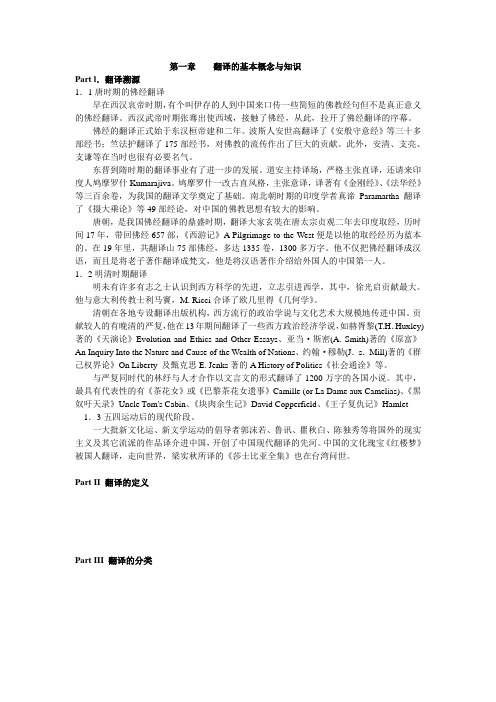
第一章翻译的基本概念与知识Part l.翻译溯源1.1唐时期的佛经翻译早在西汉哀帝时期,有个叫伊存的人到中国来口传一些简短的佛教经句但不是真正意义的佛经翻译。
西汉武帝时期张骞出使西域,接触了佛经,从此,拉开了佛经翻译的序幕。
佛经的翻译正式始于东汉桓帝建和二年。
波斯人安世高翻译了《安般守意经》等三十多部经书;竺法护翻译了175部经书,对佛教的流传作出了巨大的贡献。
此外,安清、支亮、支谦等在当时也很有必要名气。
东晋到隋时期的翻译事业有了进一步的发展。
道安主持译场,严格主张直译,还请来印度人鸠摩罗什Kumarajiva。
鸠摩罗什一改古直风格,主张意译,译著有《金刚经》、《法华经》等三百余卷,为我国的翻译文学奠定了基础。
南北朝时期的印度学者真谛Paramartha翻译了《摄大乘论》等49部经论,对中国的佛教思想有较大的影响。
唐朝,是我国佛经翻译的鼎盛时期,翻译大家玄奘在唐太宗贞观二年去印度取经,历时间17年,带回佛经657部,《西游记》A Pilgrimage to the West便是以他的取经经历为蓝本的。
在19年里,共翻译山75部佛经,多达1335卷,1300多万字。
他不仅把佛经翻译成汉语,而且是将老子著作翻译成梵文,他是将汉语著作介绍给外国人的中国第一人。
1.2明清时期翻译明未有许多有志之士认识到西方科学的先进,立志引进西学,其中,徐光启贡献最大。
他与意大利传教士利马竇,M. Ricci合译了欧几里得《几何学》。
清朝在各地专设翻译出版机构,西方流行的政治学说与文化艺术大规模地传进中国。
贡献较人的有晚清的严复,他在13年期间翻译了一些西方政治经济学说,如赫胥黎(T.H.Huxley)著的《天演论》Evolution and Ethics and Other Essays、亚当·斯密(A. Smith)著的《原富》An Inquiry Into the Nature and Cause of the Wealth of Nations、约翰·穆勒(J.s.Mill)著的《群己权界论》On Liberty 及甄克思E. Jenks著的A History of Politics《社会通诠》等。
《英语翻译教案》课件
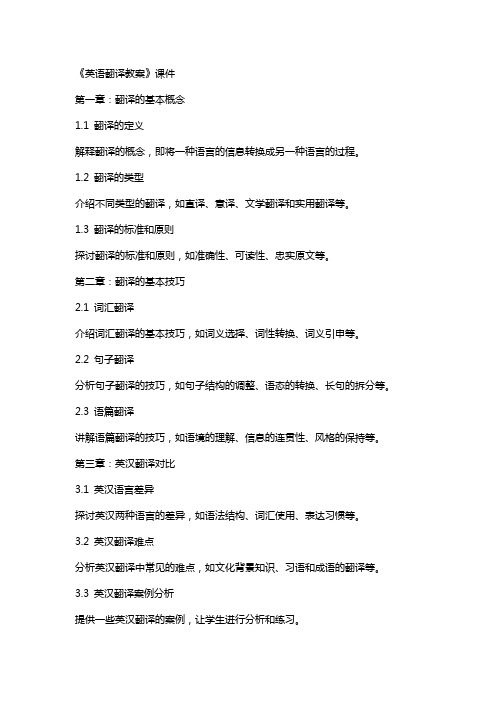
《英语翻译教案》课件第一章:翻译的基本概念1.1 翻译的定义解释翻译的概念,即将一种语言的信息转换成另一种语言的过程。
1.2 翻译的类型介绍不同类型的翻译,如直译、意译、文学翻译和实用翻译等。
1.3 翻译的标准和原则探讨翻译的标准和原则,如准确性、可读性、忠实原文等。
第二章:翻译的基本技巧2.1 词汇翻译介绍词汇翻译的基本技巧,如词义选择、词性转换、词义引申等。
2.2 句子翻译分析句子翻译的技巧,如句子结构的调整、语态的转换、长句的拆分等。
2.3 语篇翻译讲解语篇翻译的技巧,如语境的理解、信息的连贯性、风格的保持等。
第三章:英汉翻译对比3.1 英汉语言差异探讨英汉两种语言的差异,如语法结构、词汇使用、表达习惯等。
3.2 英汉翻译难点分析英汉翻译中常见的难点,如文化背景知识、习语和成语的翻译等。
3.3 英汉翻译案例分析提供一些英汉翻译的案例,让学生进行分析和练习。
第四章:翻译实践4.1 翻译练习设计一些翻译练习题,让学生进行实践操作,提高翻译能力。
4.2 翻译案例分析提供一些真实的翻译案例,让学生进行分析和讨论。
4.3 翻译评价和反馈对学生的翻译进行评价和反馈,指出其优点和不足之处,并进行指导。
第五章:翻译工具和资源5.1 翻译软件和工具介绍一些常用的翻译软件和工具,如谷歌翻译、有道词典等。
5.2 翻译资源和参考资料推荐一些翻译参考书籍、在线资源和翻译社群,供学生学习和交流。
5.3 翻译实践平台介绍一些翻译实践平台,如翻译公司、在线翻译平台等,供学生寻找实践机会。
第六章:专业翻译领域简介6.1 商务翻译介绍商务翻译的概念、特点和应用领域。
分析商务翻译中的常见问题和应对策略。
6.2 技术翻译探讨技术翻译的定义、要求和常见挑战。
举例说明技术翻译的实践案例和技巧。
6.3 法律翻译讲解法律翻译的基本原则和注意事项。
分析法律翻译中的专业术语和语言特点。
第七章:翻译与跨文化交际7.1 文化差异对翻译的影响探讨不同文化背景对翻译的影响和挑战。
翻译概论

目录
第一节 我国翻译简史
第二节 翻译的基本原理
第三节 翻译理论的主要流派 第四节 翻译的方法与技巧
第一节 我国翻译简史
• 按照不同历史时期的次序,把中国翻译史大致分为以下几个阶 段: • 一、东汉至唐宋的佛经翻译; • 二、明末清初的科技翻译及清末的西方政治思想与文学翻译; • 三、“五四”运动后马列主义的引进及俄苏等新文化、新思想 的翻译; • 四、建国后翻译事业的全面发展。
种语言在内容和形式不可分割的统一中业已表达出来的东西,准确而
• 意大利比较文学窳梅雷加利认为“虽然翻译的最终结果大 概是属于语言,而后又属于文学范畴的,可是翻译行为的 本质是语际性,它是自然语言所形成的各个人类岛屿之间 的桥梁”;
• 中国著名翻译家张培基先生认为“翻译是运用一种语言把 另一种语言所表达的思维内容准确而完整的重新表达出来 的语言活动”; • 中国翻译家张今说“翻译是两个语言社会(language community)之间的交际过程和交际工具,它的目的是要 促进本语言社会的政治、经济和文化进步,它的任务是要 把原作中包含的现实世界的逻辑印象或艺术印象,完好无 损地从一种语言移注到另一种语言中去”;
一、东汉至唐宋的佛经翻译
佛经翻译是我国历史上出现的最早的、具有较大规模的文 字翻译活动。从东汉开始到唐宋时期,历经发生、发展到鼎 盛的过程,历时一千多年。
早在东汉桓帝建和二年时(公元148年),波斯帝国(今伊 朗)的安世高来到中国,开始了较大规模地从事译经活动。他
翻译了三十部四十卷佛经,其中最著名的是《安般守意经》。
二、翻译的类型
翻译是一个笼统的概念,可以从不同的角度分成多种类型。 首先,就涉及的语言而论,翻译大体上可以分为两大类: 一类为语内翻译(intra-lingual translation)指在同一种语言 内进行翻译,如把古汉语译为现代汉语,把文言文本译为白 话文本,把广东话译为普通话等等;一类为语际翻译(interlingual translation)指把一种语言译成另一种语言,如把汉 语文本译为英语文本,或把英语文本译为汉语文本等。
考研英语基础翻译

考研翻译基础班讲义课程简介以讲解翻译基础知识为主,基本不涉及考研翻译的真题。
但是,真题很重要,有必要在强化训练中完全掌握真题。
课程大纲第一章考研翻译基础知识一翻译的定义二翻译的标准和翻译的方法三翻译的基本过程四考研翻译的核心解题策略第二章翻译技巧:词法翻译法一词义选择和词义引申二词性转换三增词法四省略法第三章翻译技巧:句法翻译法一名词性从句的翻译二定语从句的翻译三状语从句的翻译四被动结构的翻译第一讲翻译的定义翻译是一门语言的艺术,是语言之间的转换,是在准确理解的基础上用一种语言来忠实的表达另外一种语言。
考研翻译简介(一)考研翻译考查内容和形式根据全国硕士研究生统一考试英语考试大纲规定,考研翻译“主要考查考生准确理解内容或结构复杂的英语材料的能力。
要求考生阅读一篇约400词的文章,并将其中5个划线部分(约150词)译成汉语,要求译文准确、完整、通顺。
考生在答题卡2上作答。
”以2007年考研翻译题为例,考生在试卷上阅读的是一篇完整的文章,翻译的是5个划线部分。
如:Part CTranslation:Directions:Read the following text carefully and then translate the underlined segments into Chinese.Your translation should be written clearly on ANSWER SHEET2. (10 Points)The study of law has been recognized for centuries as a basic intellectual discipline in European universities. However, only in recent years has it become a feature of undergraduate programs in Canadian universities. 46)Traditionally, legal learning has been viewed in such institutions as the special preserve of lawyers, rather than a necessary part of the intellectual equipment of an educated person. Happily, the older and more continental view of legal education is establishing itself in a number of Canadian universities and some have even begun to offer undergraduate degrees in law.If the study of law is beginning to establish itself as part and parcel of a general education, its aims and methods should appeal directly to journalism educators. Law is a discipline which encourages responsible judgment. On the one hand, it provides opportunities to analyze such ideas as justice, democracy and freedom. 47) On the other, it links these concepts to everyday realities in a manner which is parallel to the links journalists forge on a daily basis as they cover and comment on the news. For example, notions of evidence and fact, of basic rights and public interest are at work in the process of journalistic judgment and production just as in courts of law. Sharpening judgment by absorbing and reflecting on law is a desirable component of a journalist's intellectual preparation for his or her career.48) But the idea that the journalist must understand the law more profoundly than an ordinary citizen rests on an understanding of the established conventions and special responsibilities of the new media.Politics or, more broadly, the functioning of the state, is a major subject for journalists. The better informed they are about the way the state works, the better their reporting will be. 49) In fact, it is difficult to see how journalists who do not have a clear grasp of the basic features of the Canadian Constitution can do a competent job on political stories.Furthermore, the legal system and the events which occur within it are primary subjects for journalists. While the quality of legal journalism varies greatly, there is an undue reliance amongst many journalists on interpretations supplied to them by lawyers. 50) While comment and reaction from lawyers may enhance stories, it is preferable for journalists to rely on their own notions of significance and make their own judgments. These can only come from a well-grounded understanding of the legal system(二)考研翻译的评分标准根据大纲规定,考研翻译的评分标准如下:5个小题,每题2分,共10分。
【外语课件】笔译(电子教案)

【外语课件】笔译(电子教案)第一章:笔译概述1.1 笔译的定义与特点解释笔译的概念分析笔译与其他翻译形式的区别强调笔译的重要性和应用范围1.2 笔译的历史与发展介绍笔译的起源和发展过程分析重要历史事件对笔译的影响探讨现代科技对笔译的推动作用1.3 笔译的类型与功能区分不同类型的笔译(如文学翻译、商务翻译、科技翻译等)阐述各类型笔译的特点和应用场景探讨笔译在不同文化背景下的功能和作用第二章:笔译基本原则与策略2.1 笔译基本原则介绍忠实原则、达意原则、等效原则等分析这些原则在实际笔译中的应用和重要性2.2 笔译策略与技巧介绍直译、意译、归化、异化等翻译策略探讨这些策略在不同翻译场景中的运用和效果分析常见的笔译技巧(如词义选择、语义转换、修辞处理等)2.3 笔译过程中的注意事项强调语言准确性、文化适应性、保持原文风格等方面的注意事项探讨如何处理翻译中的模糊、双关、幽默等特殊问题分析解决翻译中可能遇到的困难和挑战的方法第三章:笔译实践与案例分析3.1 文学笔译实践选取文学作品的片段进行笔译练习分析文学翻译中的特殊问题和挑战讨论文学翻译中的艺术性和创造性3.2 商务笔译实践提供商务文本的笔译案例分析商务翻译中的专业术语、商业礼仪等方面的注意事项探讨商务翻译在跨文化交际中的作用和影响3.3 科技笔译实践选取科技文章的片段进行笔译练习分析科技翻译中的专业术语、技术描述等方面的特点探讨科技翻译在传播知识和信息中的重要性第四章:笔译质量评估与标准4.1 笔译质量评估的方法与指标介绍主观评估和客观评估等评估方法分析语言准确性、表达流畅性、文化适应性等评估指标4.2 笔译质量的标准与要求探讨笔译质量的高低标准分析不同类型笔译的质量要求和文化差异强调笔译中的常见错误和避免方法4.3 提高笔译质量的途径与建议介绍提高笔译质量的方法和技巧分析翻译实践、翻译批评、继续教育等方面的重要性提供实用的笔译建议和技巧第五章:笔译与跨文化交际5.1 笔译与跨文化交流的关系强调笔译在跨文化交流中的作用和重要性分析笔译在促进不同文化相互理解和交流中的贡献5.2 跨文化因素对笔译的影响探讨文化差异、语言障碍、思维方式等跨文化因素对笔译的影响分析这些因素在笔译过程中的应对策略和方法5.3 笔译中的跨文化适应与调整介绍如何在笔译中适应不同文化的特点和需求探讨笔译中的文化转换、文化注释、文化适应等技巧分析成功的跨文化笔译案例和经验第六章:笔译与语言学习6.1 笔译与外语学习的关系探讨笔译对外语学习的影响和贡献分析通过笔译实践提高外语水平的方法和技巧6.2 笔译在语言教学中的应用介绍笔译在外语教学中的作用和重要性分析如何将笔译练习融入外语教学课程探讨笔译教学对学生语言技能发展的影响6.3 提高笔译能力的语言学习策略强调词汇、语法、语篇等语言知识在笔译中的重要性介绍听力、口语、阅读、写作等语言技能在笔译中的应用分析通过语言学习提高笔译能力的方法和技巧第七章:笔译与职业发展7.1 笔译行业的现状与趋势分析笔译行业的就业前景和发展趋势探讨数字化、全球化等对笔译行业的影响7.2 笔译职业技能与素养介绍笔译人员的职业要求和技能素养分析笔译人员的专业知识、语言能力、翻译技巧等方面的要求7.3 笔译职业发展与规划探讨笔译人员的职业发展路径和机会分析如何进行职业规划以提升笔译人员的职业竞争力第八章:笔译与翻译研究8.1 笔译研究的重要性与意义强调笔译研究对翻译理论与实践的贡献探讨笔译研究对翻译教育和培训的影响8.2 笔译研究的方法与框架介绍翻译研究的方法和框架分析如何运用这些方法和框架进行笔译研究8.3 笔译研究的现状与趋势探讨当前笔译研究的主题和热点分析未来笔译研究的发展趋势和方向第九章:笔译与翻译技术9.1 翻译技术在笔译中的应用介绍计算机辅助翻译(CAT)、机器翻译(MT)、云翻译等翻译技术分析这些技术在笔译过程中的作用和优势9.2 翻译软件与工具的使用介绍常用的翻译软件和工具(如SDL Trados、MemoQ、DeepL等)分析如何有效地使用这些软件和工具提高笔译效率9.3 翻译技术的局限性与挑战探讨翻译技术在笔译中的局限性和挑战分析如何应对这些局限性和挑战,提高笔译质量第十章:笔译案例分析与实践10.1 笔译案例分析提供具有代表性的笔译案例分析这些案例中的翻译策略、技巧和难点10.2 笔译实践与反馈安排学生进行笔译实践提供反馈和建议,帮助学生提高笔译能力10.3 笔译案例库的构建与运用介绍如何构建笔译案例库分析如何运用案例库进行笔译教学与实践第十一章:笔译与版权问题11.1 笔译与版权法律的关系介绍版权法律的基本概念和原则分析版权法律对笔译活动的影响和限制11.2 笔译中的版权问题与案例探讨笔译中常见的版权问题(如授权、侵权、改编等)分析具体的版权案例,解释其法律依据和处理结果11.3 笔译人员与版权保护强调笔译人员在版权保护中的责任和义务介绍如何避免版权侵权行为,保护自己的翻译作品第十二章:笔译与全球化12.1 全球化背景下的笔译活动分析全球化对笔译活动的影响和挑战探讨笔译在全球化进程中扮演的角色12.2 跨文化笔译与全球化强调跨文化笔译在全球化中的重要性探讨如何通过笔译促进跨文化交流与理解12.3 全球化与笔译产业发展分析全球化对笔译产业的影响和推动作用探讨数字化、网络化等趋势对笔译产业的影响和发展机会第十三章:笔译与翻译批评13.1 翻译批评的定义与功能解释翻译批评的概念和目的强调翻译批评对提高笔译质量和翻译研究的重要性13.2 翻译批评的理论与方法介绍翻译批评的主要理论和方法分析如何运用这些理论和方法进行有效的翻译批评13.3 翻译批评的实践与案例分析提供具体的翻译批评案例分析这些案例中的评价标准、观点和结论第十四章:笔译与翻译伦理14.1 翻译伦理的基本原则与内容介绍翻译伦理的基本原则和价值观强调翻译人员在笔译活动中应遵循的道德规范14.2 笔译中的伦理问题与案例探讨笔译中常见的伦理问题(如忠实原意、尊重原作者、保护客户隐私等)分析具体的伦理案例,解释其道德依据和处理结果14.3 翻译伦理在笔译教学与实践中的应用强调翻译伦理在笔译教学和实践中的重要性介绍如何培养和强化翻译人员的伦理意识和责任感第十五章:笔译与未来挑战15.1 未来社会与笔译的挑战分析未来社会发展趋势对笔译活动的挑战和影响探讨数字化、自动化、等因素对笔译的影响和改变15.2 笔译教育的未来方向强调笔译教育在应对未来挑战中的作用和重要性探讨如何调整和改进笔译教育,以适应未来的需求和发展15.3 笔译人员的未来素养与职业发展强调笔译人员在未来所需的素养和技能分析笔译人员的职业发展趋势和机会,提供相应的建议和指导重点和难点解析本文主要介绍了笔译的概念、历史、原则、策略、实践、质量评估、跨文化交际、语言学习、职业发展、翻译研究、翻译技术、版权问题、全球化、翻译批评、翻译伦理和未来挑战等方面的内容。
翻译基础词法翻译

目录
• 翻译基础概述 • 词法翻译基本概念 • 名词词法翻译 • 动词词法翻译 • 形容词与副词词法翻译 • 介词、连词与冠词词法翻译 • 总结回顾与拓展延伸
01
翻译基础概述
翻译定义与分类
翻译定义
翻译是将一种语言中的文本转换成另一种语言中的等效 文本的过程,涉及语言、文化和交际等多个方面。
04
动词词法翻译
动词时态与语态形式翻译
一般现在时
表示经常性或习惯性的动作,或客观事实 和普遍真理。在翻译时,通常翻译为“经 常”、“通常”、“总是”等。
被动语态
表示主语是动作的承受者。在翻译时,需 根据汉语表达习惯,灵活处理为“被”、 “由……所”、“受到”等。
一般过去时
表示过去某个时间里发生的动作或状态。 在翻译时,需根据上下文灵活处理,可翻 译为“曾经”、“以前”、“过去”等。
交流。
文化传承
翻译在文化传承中发挥着重要作用, 可以将不同文化的精髓和特色传递给
更广泛的人群。
知识传播
通过翻译,人们可以获取来自不同国 家和文化的知识和信息,促进知识的 传播和共享。
经济发展
随着全球化的深入发展,翻译在国际 贸易、商务洽谈等领域中的需求越来 越大,对经济发展的推动作用也日益 显著。
02
常见误区及避免方法
直译与意译的误区
避免过度直译或意译,根据语境 和表达习惯进行适当的调整,使 译文既忠实于原文又符合目标语
言的表达习惯。
文化差异的误区
注意源语言和目标语言之间的文 化差异,避免将源语言的文化特 色直接照搬到目标语言中,造成
文化冲突或误解。
专业术语的误区
对于专业领域的术语,要确保准 确理解和翻译,避免出现歧义或
英语翻译的定义,范例讲解
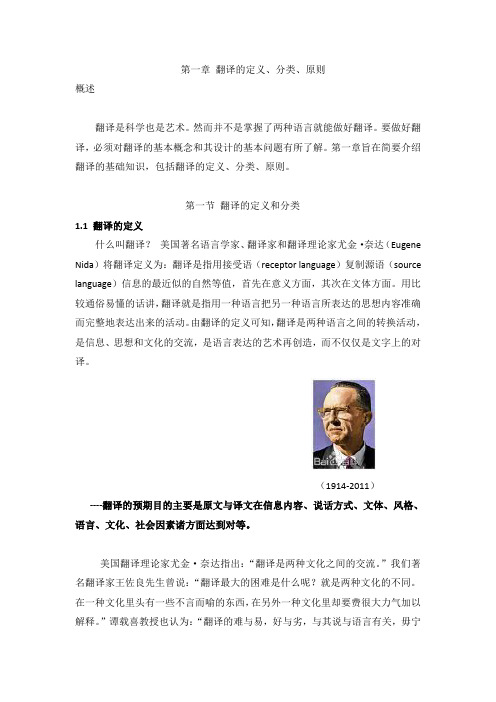
第一章翻译的定义、分类、原则概述翻译是科学也是艺术。
然而并不是掌握了两种语言就能做好翻译。
要做好翻译,必须对翻译的基本概念和其设计的基本问题有所了解。
第一章旨在简要介绍翻译的基础知识,包括翻译的定义、分类、原则。
第一节翻译的定义和分类1.1 翻译的定义什么叫翻译?美国著名语言学家、翻译家和翻译理论家尤金·奈达(Eugene Nida)将翻译定义为:翻译是指用接受语(receptor language)复制源语(source language)信息的最近似的自然等值,首先在意义方面,其次在文体方面。
用比较通俗易懂的话讲,翻译就是指用一种语言把另一种语言所表达的思想内容准确而完整地表达出来的活动。
由翻译的定义可知,翻译是两种语言之间的转换活动,是信息、思想和文化的交流,是语言表达的艺术再创造,而不仅仅是文字上的对译。
(1914-2011)----翻译的预期目的主要是原文与译文在信息内容、说话方式、文体、风格、语言、文化、社会因素诸方面达到对等。
美国翻译理论家尤金·奈达指出:“翻译是两种文化之间的交流。
”我们著名翻译家王佐良先生曾说:“翻译最大的困难是什么呢?就是两种文化的不同。
在一种文化里头有一些不言而喻的东西,在另外一种文化里却要费很大力气加以解释。
”谭载喜教授也认为:“翻译的难与易,好与劣,与其说与语言有关,毋宁说主要与文化有关。
”翻译是源语文化与译语文化的共同行为,译著是源语文化与译语文化相互作用的结果。
翻译改造了文化异质,同时又保持了文化异质。
翻译所展示的文化既不是彻底的源语文化,又不是彻底的译语文化,而是一种具有本土化的异质文化,一种让读者既熟悉又陌生的文化。
所谓文化“传真”就是要求译语从文化意义的角度准确地再现源语文化所要传达的意义、形式与风格,它是文化翻译的基本准则。
示例拿红楼梦来说,就有许多不同的版本。
著名红学专家周汝昌说:“《红楼梦》是我们中华民族的一部古往今来、绝无仅有的‘文化小说’。
- 1、下载文档前请自行甄别文档内容的完整性,平台不提供额外的编辑、内容补充、找答案等附加服务。
- 2、"仅部分预览"的文档,不可在线预览部分如存在完整性等问题,可反馈申请退款(可完整预览的文档不适用该条件!)。
- 3、如文档侵犯您的权益,请联系客服反馈,我们会尽快为您处理(人工客服工作时间:9:00-18:30)。
第一节 翻译的类型
罗曼·雅可布逊的这三种类型的划分具有重要的意义。他使我们认识了广 义和狭义的翻译概念。雅可布逊首次提出了翻译中的对等概念。在语内翻译 中,是用一个语符单位替代另一个语符单位,对一个词的翻译可以选用同义 词或者迂回表达法。但同义词不可能是完全对等的词,而改换说法会使原意 有增减。同样,在语际翻译中,符号与符号之间一般也没有完全的对等关 系。人们通常不是用一种语言的语符替代另一种语言中的单个的符号,而是 替代“更大的单位”,即“信息”(message),是用信息替代信息。也就
Translation is the “the transfer of ‘meaning’ from one set of language signs to another set of language signs” (Lawendowski, 1978:267).
Translating consists in reproducing in the receptor language the closest natural equivalent of the source-language message, first in terms of meaning and secondly in terms of style (E. Nida, 1969/1982:12).
Translation is a pane of glass through which we look at the work of art
(G. Mounin).
Translation should produce a version which may be read with as much pleasure as the original, and yet remain faithful to its spirit, sense and style (A. V. Federov).
语际翻译(interlingual translation, an interpretats of some other language),是指两种语言之 间的翻译,即用另一种语言的语符来解释一种语言的语符,这就是人们 通常所指的“翻译”,如英汉翻译。
Translation is “an interpretation of verbal signs by means of some other language” (Jakobson, 1959/1966: 233).
Translation is the expression in another language (or target language) of what has been expressed in another, source language, preserving semantic and stylistic equivalences (Dubois).
第一章 翻译的基本知识
主讲:郭彧斌 西藏民族学院外语学院
1
第一节 翻译的类型
根据语言学家罗曼·雅可布逊(Roman Jakobson)(1959/1966:233) 论述,翻译可以分成三种类型:
语内翻译(intralingual translation, an interpretation of verbal signs by means of other signs in the same language),是 指同一语言中用一些语言符号解释另一些语言符号,如古文翻译成现代 文。
符际翻译(intersemiotic translation, an interpretation of verbal signs by means of nonverbal sign system),是指通过非语 言的符号系统解释语言符号,或用语言符号解释非语言符号,如把语言 符号用图画、手势、数学、电影或音乐来表达。
是说, 在语际翻译中,我们所关注的不仅是符号与符号之间的对应(即逐词对 应),而且也关注符号和符号组合的对等。翻译所涉及的是两种不同语符的 对等信息。但双语符之间不存在完全对等的关系,对等关系存在于符号所承 载的信息。因此,语际翻译不是符号翻译,而是信息转换(李文革, 2004)。符际翻译的内容更是广泛多样,把语言符号转换为其他形式,如图 画、电影、电视或音乐,其改编的幅度可能更大,常会涉及情节、内容、人 物等的较大更改。雅可布逊对翻译的三种分类,表明他对语言概念的观点, 即语言概念是广泛的和无所不包的。这三种类型的翻译,几乎包括了一切语 言(和非语言)的交际活动。
5
(T. Savory, 1959: 13).
第二节 东西方学者论翻译
Translation, essentially, is the faithful representation, in one language, of what is written or said in another.
The Book of Changes says that the first requisite of rhetoric is truthfulness; Confucius says that expressiveness is all that matters in language. He adds that if one’s language lacks grace, it won’t go far. These three qualities then are the criterion of good writing and, I believe, of good translation too. Hence besides faithfulness and expressiveness I also aim at elegance.)
4
第二节 东西方学者论翻译
翻译是把一种语言文字所表达的意义用另一种语言文字表达出 来,具体说来,就是“换易言语使相解也”([唐]贾公彦《义疏》)。
翻 译的定义是开放性的,而不是排斥性的。其目的不是要给翻译套上
“紧 箍咒”,或给出一个十全十美的定义,而是通过各家对翻译概念的论 述,来展现翻译的特性和本质。 一.西方翻译家、翻译理论家观点: 语文学观点:
8
第二节 东西方学者论翻译
鲁迅:信、顺 凡是翻译,必须兼顾两面,一则当然力求其易解,一则保存原作的
丰姿。(《翻译论集》) 林语堂:忠实标准、通顺标准、美的标准
翻译是一种艺术。…翻译的艺术所依赖的:第一是译者对于原文文 字上及内容上透彻的了解,第二是译者有相当的国文程度,能写清顺畅 达的中文,第三是译事上的训练,译者对于翻译标准及手术的问题有相 当的见解。(《翻译论集》) 朱生豪论翻译
7
第二节 东西方学者论翻译
二.中国翻译家、翻译理论家学者观点: 严复:信、达、雅
译事三难信、达、雅。求其信已大难矣。顾信矣不达。虽译犹不译 也。则达尚焉。…易曰修辞立诚。子曰辞达而已。又曰言之无文,行之 不远。三者乃文章正轨,亦即为译事楷模。故信达而外,求其尔雅。 (严复:《天演论》序言)
(Translation has to do three difficult things: to be faithful, expressive, and elegant. It is difficult enough to be faithful to the original, and yet if a translation is not expressive, it is tantamount to having no translation. Hence expressiveness should be required too.
(注解:作为翻译的语言学派的重要人物,Fedrove在这里却提出了一个 翻译的文艺学观点。可见,文学翻译归根到底是艺术。)
语言学观点:
Translation is the “the replacement of textual material in one language (SL) by equivalent textual material in another language (TL)” (J. C. Catford, 1965:20).
The translation should have all the ease of the original composition (A. Tytler).
Translation, the surmounting of the obstacles, is made possible by an equivalence of thought that lies behind its different verbal expressions
功能理论观点: Translation is the production of a functional target text maintaining a
relationship with a given source text that is specified according to the intended or demanded function of the target text (Nord, 1991:28). Translation is a written communication in a second language having the same meaning as the written communication in a first language ().
6
第二节 东西方学者论翻译
Translation is the replacement of a representation of a text in one language by a representation of an equivalent text in a second language. (Meetham and Hudson).
